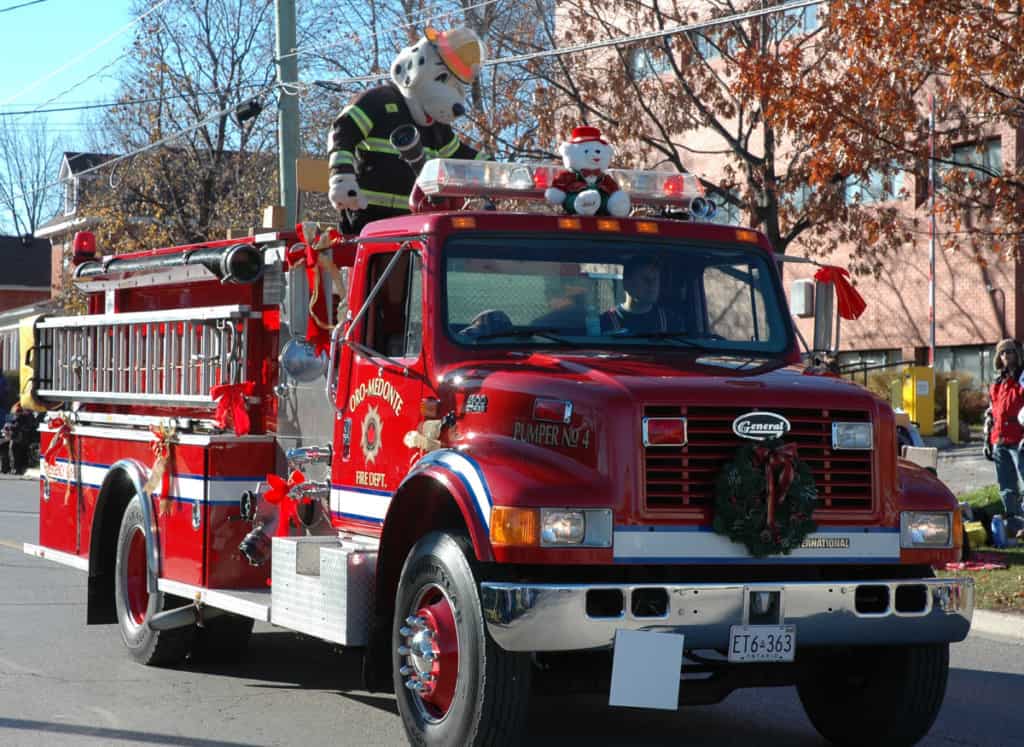If you want to be a firefighter or a paramedic, you’ll need to become an EMT (Emergency Medical Technician) first. It’s worth noting that many people choose to remain an EMT and it’s a career in its own right too.
It usually costs between $1000 and $6000 dollars to become an EMT (Emergency Medical Technician). The cost will vary by location and type of EMT program. Becoming a paramedic will generally cost an additional $3000 to $15,000 after you are EMT certified.
That means becoming an EMT is one of the more affordable career choices in America today. So, let’s take a look at what it’s going to entail, exactly, for you financially if you want to become an EMT or go on to become a paramedic.
We’ve got a separate article on how much it costs to become a trained firefighter, if you want to become a firefighter after completing your EMT or paramedic education.
Your # 1 priority is keeping your family safe. As a firefighter, I recommend everyone has updated smoke detectors that don’t require battery changes, like these ones from Kidde, a fire extinguisher, like this one from Amerex, and a fire escape ladder if you have bedrooms above the first floor, I recommend this one from Hausse.
Also read: Can You Live Off an EMT or Paramedic Salary? $$$
What Does An EMT Course Cost?

An EMT course’s cost will vary depending on a number of variables.
The first is whether you opt for a public or private training provider. As a rule of thumb, a public provider (like a community college) is likely to be cheaper than a private one, though this may not always be the case.
It’s also worth noting that if you decide to stay in the state that you live in, you can often save money on the cost of tuition through a public provider as well as potentially saving money on travel and accommodation costs too.
However, typically, these courses last for no more than 3 months and the fees run between $1,000 and $1,750.
However, sometimes you will end up paying much, much more through some providers, which is why we gave a “high end” figure at the start of this article.
We would not recommend spending anything more than you have to, in order to get your EMT certification, however.
Unlike say, surgeon’s work, where you study for an EMT is not likely to have much impact on your job offers and salary as an EMT, so there’s no incentive to spend more as there’s no “Ivy League” equivalent for EMTs.
Also read: The Difficulty of EMT School: Is It That Hard to Pass?
Should I Stay In My State To Become An EMT?
Unless there’s a compelling reason to leave your state to study to become an EMT, we’d recommend that you stay local.
It’s cheaper to do it that way, it’s usually more time-efficient too, particularly if you’re staying with relatives or in your current residence than it is to move states and commute.
And again, there’s no “best location” for EMT courses. You’re not gaining anything by moving in terms of employment or compensation, it’s probably best if you can hold off moving until you get a job offer.
Also read: What Shifts Do EMTs/Paramedics Work? Schedules Examined
Is It Expensive To Become An EMT?
It depends on what you consider expensive, to be fair. If you don’t have $1,000 in course fees laying around then $1,000 is going to feel expensive.
But, compared to other forms of medical training, it’s fair to say that learning to be an EMT is pretty cheap.
It is a bit of a pain that you have to pay for these courses upfront and we can appreciate that for some people that’s a huge financial burden (though see our advice on how to get help with this a bit later on in the article) but no, in general terms, it’s not expensive to become an EMT.
Also read: How to Become an EMT: Expert Guide
What Is Included In The EMT Course Fees?
The course fees typically cover your training and development within the college and don’t extend to books, materials, transport, accommodation, etc.
You would expect to get:
- All training relating to EMT duties for managing respiratory, cardiac, and trauma-driven emergencies and how to assess patient’s needs
- All training relating to handling typical emergency call-outs which might include emergency childbirth, cardiac arrest, fainting, broken bones, and fractures
- Classroom lessons and practical (where possible) demonstrations and labs
You might get:
- On-the-job ride-along training and hospital observation sessions
- Some intermediate training to prepare for an advanced EMT course (this might include IV insertion and the use of airway devices)
Also read: What Jobs Can You Get With An EMT Certification? 11 Jobs
What Do The Books And Materials (Needed To Become An EMT) Cost?
You may need to buy books and materials and other items for your course; this can include:
- $100+ for the books that you need for the program, they will provide a reading list for you, and typically, you can save money by searching down the texts secondhand
- You will need to recertify after you pass the classes every 2 years or so, this won’t be included in course costs
- You may need to provide certain evidence of vaccination and/or the absence of certain diseases and if you haven’t done this before, you will need to pay for them, vaccines start at $50 each and a TB test is around $100
- You will probably need a basic first-aid certificate before you can start the program – these are super cheap and only take a couple of days to pass – you will spend less than $100 in most places on this
Also read: Is EMT a Good Job/Career? Is it Worth It?
Is Certification Testing (NREMT) Included In The EMT Course Fee?
Typically, the fees for certification are not included in the EMT course fees and may cost up to $200 at the end of the course.
If you fail the test and need to re-sit it, then you would need to pay these fees again.
Also read: Is The EMT State Exam/Test (NREMT) Hard To Pass?
Can I Get Any Help With EMT School Tuition?
It depends on where you live and your current circumstances but you may find you can benefit from some or all of the following:
- The local health authority or education authority (depending on which has responsibility for EMT courses in your area) may offer bursaries or scholarships to cover some or all of the fees for those in financial hardship – Google to find out if this might apply for you
- If you are employed already, your employer may offer some help towards course fees or examinations (ask your HR department) and certainly if you are employed as an EMT following completion of the course, your employer should pay your recertification costs
- If you take other EMT courses, you may find that your pay and conditions improve as per the federal government’s “Occupational Outlook Handbook”
- If you are a veteran of either Operation Iraqi Freedom or Operation Enduring Freedom, then you can use the Swords to Ploughshares program to have your tuition for EMT training and your certification costs reimbursed
- The learning provider (in some states) may also provide a discount for paying the course fees in one payment upfront
- The learning provider (in some states) may offer a small fee rebate if you complete the course on time
I’ve Found A Really Cheap EMT Course Is IT OK?
You may have heard the expression “never look a gift horse in the mouth” but when it comes to cheap courses? In our experience, “you get what you pay for”.
Sure, a college in rural Mississippi is going to be able to cut its costs when compared to a college in urban San Francisco.
Wages are higher in California, rents are higher, etc. but there’s a point at which it’s impossible to offer a full education and if your course is much less than $1,200, the odds are that somebody’s cutting corners.
However, we’re prepared to believe in miracles too, so if you can contact former students and get references and the learning provider has great reviews online (Better Business Bureau, Yelp, etc. not on their own website or social media) then it may be that you have found an incredible deal.
You should always check that the learning provider is recognized by the certification authority for EMTs though, as you can’t become an EMT without certifying.
Also read: Is EMT A Dangerous Job? Risks and Challenges
My EMT Course Seems Expensive, What Should I Do?
Shop around. As we’ve said several times through this article, there’s no advantage to overpaying for an EMT course.
While many professional disciplines have colleges and universities which offer superior career opportunities, this is not true for most EMTs.
So, the best thing you can do is shop around for a course that is reasonably priced and meets your needs as a learner.
Useful Advice For Shopping For EMT Programs
Choose a college or learning provider that suits you but remember to look for:
- A fair price. Not every college has the same costs, but they should be reasonably similar, there’s no advantage to overpaying, and underpaying may result in low-quality learning.
- The learning provider should be listed in the Journal of Emergency Services’ accredited programs list – if it’s not an accredited course you may be denied the opportunity to certify and will need to do a whole new program of study if you still want to become an EMT!
Also read: How Long Does It Take to Become an EMT?
How Much Does It Cost To Become A Paramedic?
The next step after becoming a qualified EMT is often to become a qualified paramedic. It requires considerably more study to become a paramedic and thus, it’s quite a bit more expensive to learn to be a paramedic than an EMT.
However, it’s worth noting that the increased length of study means that paramedic courses do attract more financial aid than EMT courses.
So, don’t look at the price and think “I could never afford that”, if you want to pursue a career as a paramedic after qualifying as an EMT, you can make it happen.
Typically, tuition for a paramedic runs from $3,000 to $13,000 (or possibly more) and the cost will depend very much on where you choose to study. A paramedic program typically takes 12-18 months to complete, which is part of why it is so much more expensive.
However, paramedics are trained to a higher level than EMTs and as such, usually get higher salaries. Being a paramedic can also make it considerably easier to get hired as a professional firefighter, so keep that in mind.
Also read: 7 Reasons Why EMTs and Paramedics Are Important? [Expert Opinion]
What Is Included In The Costs Of A Paramedic Course?
A paramedic’s course fees typically include:
- All the classroom and on the job training you need to learn the skills of a paramedic (you will typically need to have worked as a licensed EMT prior to starting the course and the course will not normally teach EMT skills)
- They often include college credits or even result in an associate degree at the end of the program
- Coursework that focuses on pre-hospital care
- Sufficient practical skill training to enable you to pass the NREMT examinations
Also read: What Disqualifies You From Being An EMT/Paramedic?
What Is Not Included In The Costs Of A Paramedic Course?
Typically, these things are not included in the paramedic course costs:
- Books (which can cost up to $1,500 a year) though a technical school may include books in the fees
- EMT training (that is a cost in addition to the paramedic training)
- Certification and recertification costs with the NRMT and any refresher courses needed to pass these certifications
Also read: The Difference Between EMT And Paramedic?
Sources
Related Articles
What Is The Age Limit To Be A Paramedic/EMT?
Do Paramedics/EMTs Get Drug Tested? How Often?

